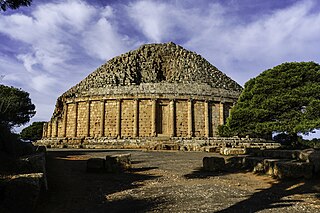
Algiers is the capital and largest city of Algeria, located in the north-central part of the country. The city's population at the 2008 census was 2,988,145 and in 2020 was estimated to be around 4,500,000.

Berbers or the Berber peoples, also called by their endonym Amazigh or Imazighen, are a diverse grouping of distinct ethnic groups indigenous to North Africa who predate the arrival of Arabs in the Arab migrations to the Maghreb. Their main connections are identified by their usage of Berber languages, most of them mutually unintelligible, which are part of the Afroasiatic language family. They are indigenous to the Maghreb region of North Africa, where they live in scattered communities across parts of Morocco, Algeria, Libya, and to a lesser extent Tunisia, Mauritania, northern Mali and northern Niger. Smaller Berber communities are also found in Burkina Faso and Egypt's Siwa Oasis.
Articles related to Algeria include:

Constantine, also spelled Qacentina or Kasantina, is the capital of Constantine Province in northeastern Algeria. During Roman times it was called Cirta and was renamed "Constantina" in honour of Emperor Constantine the Great. Located somewhat inland, Constantine is about 80 kilometres from the Mediterranean coast, on the banks of the Rhumel River.

Mauretania Caesariensis was a Roman province located in what is now Algeria. The full name refers to its capital Caesarea Mauretaniae.

Cherchell is a town on Algeria's Mediterranean coast, 89 kilometers (55 mi) west of Algiers. It is the seat of Cherchell District in Tipaza Province. Under the names Iol and Caesarea, it was formerly a Roman colony and the capital of the kingdoms of Numidia and Mauretania.

Sohag, also spelled as Sawhāj, Suhag and Suhaj, is a city on the west bank of the Nile in Egypt. It has been the capital of Sohag Governorate since 1960, before which the capital was Girga and the name of the governorate was Girga Governorate. It also included Esna Governorate.

Tipasa, sometimes distinguished as Tipasa in Mauretania, was a colonia in the Roman province Mauretania Caesariensis, nowadays called Tipaza, and located in coastal central Algeria. Since 1982, it has been declared by UNESCO a World Heritage Site. It was declared a World Heritage Site in danger in 2002, but was removed from the danger list in 2006 following conservation efforts.

The conversion of non-Islamic places of worship into mosques occurred during the life of Muhammad and continued during subsequent Islamic conquests and invasions and under historical Muslim rule. Hindu temples, Jain Temples, churches, synagogues, and Zoroastrian fire temples have been converted into mosques.

Mila is a city in the northeast of Algeria and the capital of Mila Province. In antiquity, it was known as Milevum or Miraeon, Μιραίον and was situated in the Roman province of Numidia.

Djamaa el Kebir, also known as the Great Mosque of Algiers, is a historic mosque in Algiers, Algeria. It is located within the Casbah, near the city's harbor. Dating to 1097, it is one of the few remaining examples of Almoravid architecture, although it has undergone other additions and reconstructions since its foundation. It is the oldest mosque in Algiers and is said to be one of the oldest mosques in Algeria after Sidi Okba Mosque and Sidi Ghanem Mosque.

Algeria is the largest country in Africa; one of the main tourist attractions is the Sahara, the largest desert in the world. Algeria has been a member of the World Tourism Organization since 1976. According to a report of the World Tourism Organization published in 2014, Algeria was the 4th largest tourist destination in Africa in 2013 with 2.7 million foreign tourists, and ranks 111th on the international tourism scene, according to the London-based World Tourism and Travel Council (WTTC). The tourism sector in Algeria accounts for 3.9% of the volume of exports, 9.5% of the productive investment rate and 8.1% of the gross domestic product.

The Royal Mausoleum of Mauretania is a funerary monument located on the road between Cherchell and Algiers, in Tipaza Province, Algeria.

The Archaeological Museum of Cherchell is an archaeological museum located in the center of the seaport town of Cherchell in Tipaza Province, Algeria.
Abdul-Rahman al-Tha'alibi was an Arab Scholar, Imam and Sufi wali. He was born near the town of Isser 86 km south east of Algiers. He was raised in a very spiritual environment with high Islamic values and ethics. He had great interpersonal skills and devoted his entire life in service of the most deprived, to dhikr of Allah, and to writing of over 100 books and treatises.

The Rahmaniyya is an Algerian Sufi order founded by Kabyle religious scholar Muḥammad ibn ʿAbd al-Raḥman al-Azhari Bu Qabrayn in the 1770s. It was initially a branch of the Khalwatîya established in Kabylia region. However, its membership grew unwaveringly elsewhere in Algeria and in North Africa.

The Salah Bey Mosque is a mosque in Annaba, Algeria. It was built between 1791 and 1792.

Djamaʽa el Djedid, also rendered Djamaa al-Djedid, or Jamaa El Jedid is a mosque in Algiers, the capital of Algeria. It is dated to 1660/1070 AH by an inscription over its main entrance portal. That inscription also attributes its construction to al-Hajj Habib, a Janissary governor of the Algiers region appointed by the Ottoman imperial administration in Constantinople. During the French colonial rule, the mosque was called the Mosquée de la Pêcherie and in English the Mosque of the Fisherman's Wharf.

The architecture of Algeria encompasses a diverse history influenced by a number of internal and external forces, including the Roman Empire, Muslim conquest of the Maghreb, French colonization, and movements for Algerian independence.
The Great Mosque of Constantine, or Djamâa El Kebir is a mosque located in Constantine, Algeria.



















